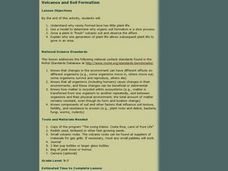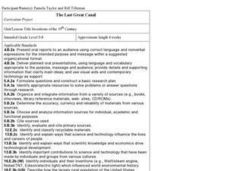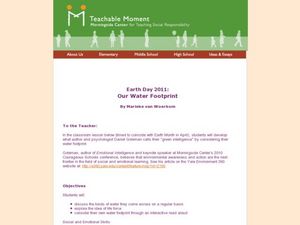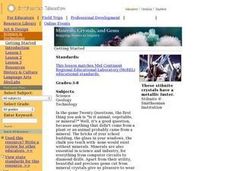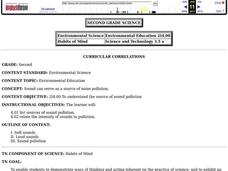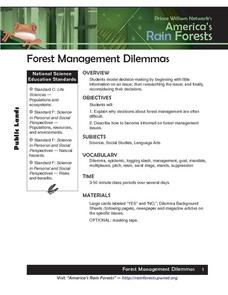Curated OER
Why So Many Frogs?
Students explain the different stages in the growth of a frog, then analyze and collect data to make generalizations about a larger population. They determine the survival rate of a population of tadpoles under controlled conditions.
Curated OER
Inventions of the 19th Century
Students explore inventions that have been created since the nineteenth century.
Curated OER
Channel Islands and the Surrounding Sea
Students examine the Channel Islands and identify its characteristics. They participate in activities to help them discover the islands history, geography and conservation efforts. They complete a worksheet to end the instructional...
Curated OER
What are Properties of Wood?
Students use hands on scientific observation to determine characteristics of wood. They work directly with the materials and record their observations. Students test if wood absorbs water, if wood floats or sinks, and if all wood...
Curated OER
What's the Big Deal?
Students explore and define methane hydrates and describe ways that it can impact their own lives. In this methane hydrate lesson students create a molecular model and research methane hydrate.
Curated OER
Water and Ice
Students observe what happens to water as it goes from a solid to a liquid. In this exploratory lesson plan students gain an understanding for the water cycle while working in groups observing what happens to water as it changes state.
Curated OER
Where's the Oxygen?
Students study seawater and how temperature and salinity influence it. In this oxygen lesson students complete a lab activity on dissolved oxygen.
Curated OER
Sars
Young scholars discuss the Sars outbreak in 2003. In this biology lesson, students research the effect of the outbreak to the world. They create a public announcement about the topic.
Curated OER
Our Water Footprint
Students discuss the water usage of the world and their own water usage. In this water lesson plan, students read a story about water and discuss different statistics of water usage around the world.
Curated OER
Learning Activities: Magic Words
Students use poetry to compare and contrast humans and frogs.
Curated OER
Minerals, Crystals, and Gems
Students discover the relationships between minerals, crystals and gems. They bring in rocks that they find at home, in the schoolyard, etc. and examine them and attempt to identify them. They set up a classroom exhibit that includes all...
Curated OER
Radical Raptors
Students study the lifestyles and habitats of raptors that live in Minnesota. They play games associated with their study.
Curated OER
Lake and Pond Study
Learners examine the habitat and community structure of a pond that could support Ospreys through games and worksheets. They then go on a field trip to a pond to evaluate the suitability of the pond as an Osprey habitat.
Curated OER
Habits of Mind
Second graders explore sound pollution. They discuss the various sources of sound pollution. Students relate the intensity of sounds to pollution. They create a collage of various causes of sound pollution.
Curated OER
What Makes A Community Sustainable
In this environment activity, students read three different case studies in order to apply them to the categories of finding the best possible choices to make for helping a community flourish.
Curated OER
Caring for the Land
Students study soil management and issues relating to agriculture and the environment. In this agriculture and environment lesson plan, students define the terms farmer, environmentalist, and activist. Students use a Venn diagram to...
Curated OER
Seabird Survival Adaptation Card Game
Students study seabirds and how they have adapted to their environments. In this activity based instructional activity students will play a card game that will allow them to have a better understanding of seabirds and their adaptations.
Curated OER
Utah's Own
Fourth graders examine the effects of humans on the environment. In this Social Studies activity, 4th graders analyze human changes to the environment. Students explore the actions and effects at a community level.
Curated OER
Plants and Animals: Partners in Pollination
Students identify the plant parts and bee structures that are involved in pollination. They simulate pollination in a group activity and process the information.
Curated OER
Natural Resources: Getting a Fair Share?
Students explore the impact of human behavior on key components of the environment, examine how theirn own personal decisions have added to the problem, and explore possible solutions to the current ecological crisis.
Curated OER
The Cantankerous Pathogen
High schoolers explore what factors influence the spread of infectious diseases. They explain how human manipulation of the environment affects the transmission of diseases.
Curated OER
Structure of the Earth
Eighth graders explain the difference between igneous, sedimentary and metamorphic rocks. They identify the stages in the rock cycle. They discover the origin of rocks as well.
Curated OER
Oil Spill Dangers
Middle schoolers analyze the effects of oil spills on our environment and develop action plans to protect animals and habitats.
Curated OER
Forest Management Dilemmas
Pupils discuss forest management dilemmas and make uninformed decisions as to whether they are appropriate management techniques. They draw bar graphs of the class opinion for each dilemma. They use media sources to become more informed...


